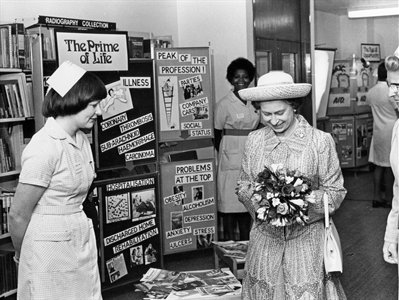University of Nottingham Medical School
History
The University of Nottingham Medical School, now in the Faculty of Medicine and Health Sciences, was established in 1964 and admitted its first students in 1970. It was the first new medical school to be created in the UK in the twentieth century.
On 27 July 1964 the Minister of Health announced in Parliament that a new medical school and teaching hospital was to be established at Nottingham. Planning began almost immediately. The University of Nottingham established a Medical School Advisory Committee to give recommendations on the planning of the new school and hospital. The committee submitted its report to the Senate of the University in April 1965. Acting on the committee’s advice a Local Joint Committee made up of representatives from the University and the NHS was established to oversee the creation of the medical school and hospital. The Local Joint Committee in turn set up a Planning Team to deal with the day to day planning.
The site selected for the new medical school and hospital was in Lenton, fronting Clifton Boulevard and Derby Road. This had the advantage of being next to the University campus, offering easy access for students and staff to the university facilities. Problems in acquiring the site, with objections from landowners and local residents, meant that building work on the new complex was delayed. Building work was originally scheduled to begin in 1969. In the end possession of the site was not gained until 1971, a year after the first medical students arrived in Nottingham.
The first students arrived at the University of Nottingham Medical School in October 1970. Teaching took place in temporary accommodation on the University Park campus and in existing Nottingham hospitals whilst work on the new school and hospital progressed. There were 48 students in the first intake. Teaching began with a staff of six professors and numerous lecturers in the foundation departments of Human Morphology, Biochemistry, Pathology, Physiology, Medicine and Community Medicine. The Dean of the Medical School, Professor Greenfield, was also the Chair of the Department of Physiology.

First entry of students to the Medical School, 1970
UAF1/6/1/3/5/4/4/1
The curriculum was divided into three parts. The first was a period of three years of training as a biological scientist, at the end of which students gained a degree in Medical Biological Sciences (BMedSci). The second was two years of clinical training, which resulted in the degree of Bachelor of Medicine Bachelor of Surgery (BMBS). In common with all newly qualified doctors graduates then had to undertake a two-year period of in-service training in approved posts. After the succesful completion of the first of these two years graduates were eligible for registration with the General Medical Council. In Nottingham the first B.Med.Sci degrees were awarded in 1973. The first medical degrees were awarded in 1975. In 1976 the first graduates completed their pre-registration year and were registered by the General Medical Council.
The building of the new Medical School and University Hospital was planned in stages. Stage 1, comprising most of the medical school accommodation and 440 hospital beds was completed in 1977. The University of Nottingham Medical School and University Hospital was officially by the Queen on 28 July 1977 and named 'Queen's Medical Centre'. Following the official opening work continued on Stage 2 of the project, to complete the remaining medical school and hospital accommodation.

The Queen at the official opening of the Queen's Medical Centre, 28 July 1977
UAF1/6/1/3/7/1/1/20
The medical faculty was gradually developed over time. Clinical academic departments were established in existing Nottingham hospitals, with NHS consultants invited to accept the university title of Clinical Teacher, and to take part in clinical teaching. When full scale clinical teaching began in 1973 the clinical departments of Surgery, Psychiatry, Obstetrics and Gynaecology, Child Health and Therapeutics had been established in the existing hospitals. These departments were gradually strengthened with the appointment of additional professors and readers. As the size of the medical faculty increased so too did the number of students. In 1975 the intake of students was doubled to 96, in 1978 it was increased again to 115 and by 1980 it had reached 130. Student intake has continued to increase and as of 2014 sits at approximately 346 students per year.
There have been changes in the curriculum and composition of the Medical School over time, resulting from reorganisations of the NHS, shifting priorities and advancements in medical education. Some of the most significant changes include the development of postgraduate courses, aimed at ensuring that those working in medicine maintain and update their knowledge and skills, the establishment of Nursing as a degree subject with the creation of the Department of Nursing (now the Division of Nursing) in 1990 and the opening of a satellite medical school in Derby in September 2003, for the teaching of a new graduate-entry medical course.
As of 2014 the Medical School sits in the Faculty of Medicine and Health Sciences.
Next page: The Medical School Collection